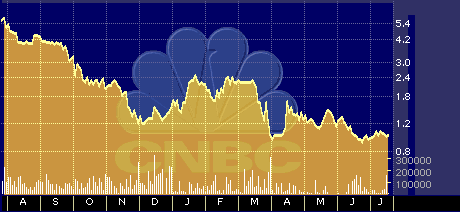
FairMarket Business Model Seen as Solid
FairMarket Business Model Seen as Solid
by Hal Plotkin
Silicon Valley Correspondent
Analysts say FairMarket Inc.’s {FAIM} novel business model gives the company a good shot at carving out a lucrative online niche.
“They come across as a very strong player,” says Anna Giraldo Kerr, senior Internet and eCommerce strategies analyst at International Data Corp., based in Boston. “I’m fairly optimistic about what they’re doing.”
So far, investors seem to be optimistic, too. The company’s stock has traded as high as 53 1/2 Tuesday, after opening at 47. Late Monday, FairMarket priced its 5 million share offering at 17, above its price target range of 13 to 15.

FairMarket post-IPO stock performance
Woburn, Mass.-based FairMarket is championing a unique hybrid approach to e-commerce infrastructure development that combines hosted private-label auctions with a syndication model that ties those auctions together to bring large numbers of buyers and sellers under a single online umbrella.
“There are other companies that do some of what they do,” Kerr says. “But I haven’t come across another company that is doing exactly what they do.”
The firm currently has upwards of 90 customers, including big names such as CompUSA Inc. {CPU}, Dell Computer Corp. {DELL} and Cyberian Outpost Inc. {COOL}, as well as leading online portals, such as Excite@Home {ATHM}, Lycos Inc. {LCOS} and Microsoft Corp.’s {MSFT} MSN.com. Microsoft and Excite own 21 percent and 15 percent of the firm, respectively, while Lycos has an option to purchase 9 percent.
The firm’s ownership structure “means their software is going to get used by some big players,” says Stan Dolberg, vice president of research at Forrester Research, based in Cambridge, Mass.
FairMarket offers a hosted service that allows online businesses to offer private-label branded auctions on their Web sites. Customers pay monthly hosting fees plus a small fee for each completed transaction. The service allows online businesses to tap into the growing popularity of online auctions without having to master the technical complexities involved in their execution.
As an added bonus, FairMarket’s customers can link the content in their auctions to the content in all other auctions hosted by the firm, a feature that gives new customers instant access to considerably more eyeballs then they could hope to attract on their own.
“FairMarket has built a technically superior auction environment that effectively combines entertainment with interactivity,” says Bob Davis, chief executive officer of Lycos, when he announced his firm’s recent investment in the firm. “Online auctions have mass audience appeal, and the FairMarket service will allow Lycos to benefit even more from this huge commerce opportunity.”
The approach is generating traction on both the business-to-business, or B2B, and business-to-consumer, or B2C, sides.
“They’re not committed to either B2B or B2C,” Kerr says. “Instead, they are building critical mass to establish themselves as an auction platform. They’re in very good company with some significant clients. It’s a very good launching pad.”
Online auctions, and similar services that combine multiple sellers and buyers in a single electronic marketplace, are expected to become a dominant form of online commerce.
In the B2B sector, for example, bilateral trade, online transactions conducted between a single buyer and a single seller, are expected to total about $351.5 billion this year, as compared with $54.7 billion in so-called e-marketplaces, which combine multiple buyers and sellers. By 2004, however, e-marketplaces are expected to take the lead, accounting for $1.41 trillion in sales, as compared with $1.27 trillion for direct seller-to-buyer transactions, according to Forrester Research.
“We expect auctions will be a significant part of that,” Dolberg says. “Auctions are just a pricing mechanism that lets the market push the price up and down. It’s extremely efficient, it works, and we see them as having multiple applications.”
Analysts say one unsettled challenge for the firm, however, is how clients might react once they gain more experience with the linked auction business model. Dell Computers, for example, which uses the FairMarket service to sell refurbished computers online, might eventually decide it doesn’t want to see its offerings pitted against those of its direct competitors, such as CompUSA.
“The idea has pluses and minuses,” Kerr says. “For shoppers, it’s a great opportunity. But if I was Dell or CompUSA, I wouldn’t want buyers to jump to the other side. On the other hand, the sellers get access to more eyeballs, which lowers their customer acquisition costs. On balance, I think the potential benefits outweigh the risks.”
The analysts warn, however, that should clients begin to balk at participating in FairMarket’s linked online auction network it could reduce the firm to the position of merely being a supplier of hosted auction services, which would substantially reduce the firm’s value.
“Their value proposition is all about having a broad structure in place that lets you inherit this giant set of eyeballs,” Dolberg says. It might not be enough, he says, for the company to simply sell its services to firms that conduct auctions totally independent of one another.
“Not every business is going to want to do auctions,” Dolberg adds. “This appeals mostly to [online] hubs, and there aren’t hundreds or thousands of them, so there is a limited number of customers for auction software. But building an auction network, that is much more interesting.”
Although analysts are hard-pressed to name direct competitors, there are several other still privately held firms, such as Research Triangle Park, N.C.-based OpenSite Technologies Inc. and Moai, based in San Francisco, that offer a somewhat overlapping set of services.
“If you’re looking at auction software, FairMarket has the visibility advantage,” Dolberg says. “They are a technology provider to a significant number of sites.”
FairMarket posted a loss of $16.5 million on revenue of $2.1 million for the year ended Dec. 31, as compared with a loss of $1.38 million on revenue of $4,000 for 1998.


